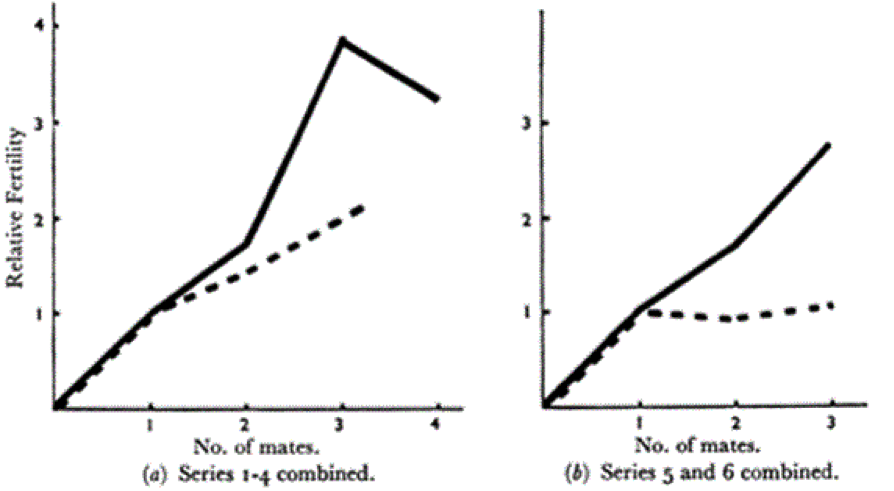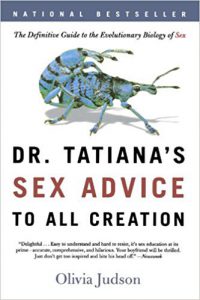Art and Culture
Reviving "Essentialism" and Other Scientific Straw Men
In fact—it’s even more interesting than that. Multiple matings do (perhaps surprisingly) benefit females in all sorts of ways across all sort of species.

Cordelia Fine’s latest attempt at human exceptionalism and biology denial Testosterone Rex has drawn rave reviews from (almost) everyone, from the popular press to Nature. Happy to go against this grain, I would like to suggest that these much-circulated rumours of the death of human nature have been somewhat exaggerated. Most of Fine’s targets are probably quite well deserved chunks of popular science, male chauvinism, and journalistic overreach. However, when she turns her sights on serious science she makes some rather egregious blunders. This is a pity—because there is much in the public understanding of sex differences that could really use some popular explication and myth busting.
Let’s start with what is positive about the book. Many will find her anecdotal approach to be engaging and charming. I didn’t, but I’m a miserable old curmudgeon who wants to get to grips with the facts, not be reassured via an anecdote about kangaroo testicles that that the writer “doesn’t hate men really”. On this point: I’m always a little unsettled by people who feel the need to start off a conversation with phrases such as “I don’t hate men,” “I’m not racist,” or “I don’t much like eating children.” Part of me wants to say “Well done you!” and give them an encouraging smile, but part of me is wondering at their need to say it in the first place. That aside, popular science seems to require anecdotes and Testosterone Rex work is very anecdote-y.
The second mostly positive thing is that Cordelia Fine explores the use and misuse of Bateman’s principle. Now—this is an important area, so I was more than happy to see it explored in popular form. The basic story is as follows: In 1948 Bateman did an important series of experiments with fruit flies in which he appeared to establish the fact that multiple matings improved male fitness, but had no effect on female fitness. Since then, people have used “Bateman’s principle” as an explanation for the apparent prevalence of male promiscuity and female sexual coyness across nature. Now, we have done a lot of work in biology since 1948 and no reputable modern biologist thinks that Bateman’s principle is true in anything like its original formulation.
In fact—it’s even more interesting than that. Multiple matings do (perhaps surprisingly) benefit females in all sorts of ways across all sort of species. Indeed—they even helped the fruit flies in Bateman’s original experiments. It is simply that Bateman himself couldn’t explain his own findings at the time, but—proper scientist that he was—he faithfully reported them all the same.

This part is by far the best part of Fine’s book, where she explores the initial experiment (with all the kooky names for the fly types) and the fact that really should be better known that Bateman himself had data that showed that multiple matings actually did increase female fitness. Incidentally, none of this is to disparage Bateman. At the time he was experimenting, no-one could think of ways that multiple matings could help females. It seems obvious that you (or a fruit fly) can’t be a “a bit pregnant”. Since Bateman’s time, we have discovered a host of ways in which multiple matings can increase female fitness—nuptial gifts, sperm selection mechanisms and so on—although Fine does not go on to talk about any of this.

At this point in Fine’s book I was quite excited—hoping for something like the superb Doctor Tatiana’s Sex Advice to the Whole of Creation by Olivia Judson. This latter was a terrific book that, also in popular form, thoroughly debunked the idea of a natural world full of coy, sexually passive females, waiting patiently for their furry, feathery, and scaly princes to come. Was Testosterone Rex going to bring an interested public up to date on sexual science—documenting the last few decades of work into exciting and evolved female sexual strategies? My hopes were high.
They were dashed. Perhaps I should not have been surprised because Fine, unlike Judson, is no biologist. However, Fine is a lecturer in the history and philosophy of science, and therefore she has no excuse for the central mistake upon which her book is based, rendering most of the rest of it a simple exercise in straw manning. The mistake is simple to state, but profound in its implications. It is one of the main pillars on which science since the enlightenment has been built. It is this: Modern science relies on the insight that functions have replaced essences. Our advances in the sciences have all required abandonment of the intuitive (but false) reliance on the idea that there are intrinsic essential properties that in any way explain the natural world. This is an important point, so I need to give some examples of how this works in detail.
As far back at the 17th Century, the French playwright Molière satirised our “essentialist” intuitions. In The Imaginary Invalid, he made the humorous observation that opium worked because of its “dormitive properties,” his point being that explaining the power of opium to induce sleep by referring to its “sleep-producing essence” is no explanation at all. But the humor conceals a deep truth. For most of human life we have believed in essences as explanations. At an intuitive level, most of us still do. We used to think that things burned because flammable stuff contained an essential substance—phlogiston. Light (we thought) moved through a special substance—the lumineferous aether; and life occurred because some entities contained an “élan vital”.
We know better now—or rather, we don’t. We’ve been told that these things are false by the large, highly counter-intuitive, and unnatural edifice of science, painstakingly built up over centuries of false starts and meticulous experimentation. And the most unnatural element of that scientific endeavour has been the process of attempting to falsify our natural beliefs, rather than do what come naturally to us humans—trying to confirm them. By way of example—the existence of a substance called phlogiston, that was burned off in flammable substance, was disproved when it was carefully measured that burned objects (considered in their entirety) actually became heavier.
“Femaleness” and “maleness” are not brute essences of nature any more than phlogiston is an essential substance that flammable materials contain. And if people have been arguing that testosterone is a sort of biological phlogiston imparting male properties, then I guess they deserve everything that Fine throws at them. Fortunately, no competent biologist would be foolish enough to make such a bizarre claim. So however estrogen-soaked (or testosterone infused) may be the Aunt Sallys and Straw men that she effortlessly knocks down, her victory is a hollow one. Here is why:
For biologists looking at species like ours which have two sexes (rather than a fungus with an insane amount of sexes) being male means having relatively small, fast-moving gametes. Sperm. Being female means having relatively large, energy rich gametes. Eggs. Those gametes are genetic material which is doing its best to get into the next generation. To this end it creates a large, but finite, set of strategic responses to being based around this core. These strategies—or processes—are not then randomly scattered throughout the resulting population. Most of those who have small fast-moving gametes will have a preponderance of testosterone (or rather the dozens of different types of testosterones—something Fine might have mentioned) but plenty of things can interfere with the realisation of this. One example could be a condition like 5-α reductase deficiency which is a fascinating condition where, due to the body’s resistance to (some) testosterone at certain developmental stages, girls can turn into boys at puberty. Incidentally, these girls turn happily and rapidly into boys, with male-typical interests and sexual desires, despite years of “female socialisation”. So much for the social construction of gender—a weak force at best.
Once again, the opportunity for an interesting and informed discussion of the range of intersex conditions like 5-α reductase deficiency, Congenital adrenal hyperplasy (CAH) or Turner’s syndrome would have been very welcome in the book. Why was such discussion largely absent? I suggest for the very simple reason that such a discussion would have required engaging with the very real effects of hormones on development and behavior—often in the teeth of predictions that Fine’s social constructionist philosophy requires of her. To give but one instance: Female CAH folk have female-typical morphologies but male-typical hormone levels. They also, despite social pressure to conform to female behavior patterns, have male-typical ones. However, the story gets even more interesting when we also consider male CAH patients. Fine could have discussed all this, but instead chose to talk about the almost-certainly irrelevant area of colour-preference. If readers are interested in non-partisan and informed discussion of these things can I suggest Alice Dreger’s excellent works on them?
At an even deeper level for evolutionary biologists “male” and “female” are convenient short-hands for a large, but finite, suite of strategies and processes. Not—and I would really like to emphasise this point, any “essences”. One example (of many) that Fine gets this badly wrong is in her discussion of Robert Trivers foundational work on differential parental investment. Trivers prediction—across species—is that the sex with the lowest potential investment in offspring will be selected to be more competitive in attaining mates, while the one with the highest minimum investment will be selected to be somewhat choosy about mates. What they are bringing to the party is always more valuable, so they guard it more keenly.

Fine does her best to rubbish the piece of common sense that females are naturally sexually pickier than males in our species, by trying to undermine the famous Clark and Hatfield study that demonstrated this experimentally. In this study, an attractive member of each sex approaches members of the opposite sex on campus with the following offer: “I have seen you around, I find you very attractive, would you like to sleep with me?” Then then count the numbers of “yes” responses and “nos”. When I describe this scenario to the students, absolutely no-one is surprised to find that none of the women accept the man’s offer, and upwards of three quarters of the men accept the woman’s. So far, so obvious. But that is not good enough for Fine. She attempts to explain this (oft-repeated) finding away as female wariness about being assaulted. Fair enough, that’s a reasonable challenge so let’s try and control for that fear and see what happens.
This is a thought experiment—so there is no danger of assault. Indeed, being a thought experiment we can control for fears of disease, reputational damage, pregnancy, jealousy, and everything else. Make yourself comfortable. Now, in your mind’s eye, line up your ten closest friends of the opposite sex (assuming you are heterosexual). Now—once again in the privacy of your own head where no one else is watching—mentally erase all those who you would, under no circumstances, have sex with. Remember—this is fantasy. No one can possibly get hurt through violence, disease, or social exclusion. Give the remaining ones an imaginary wave. Count them. Share the number (and if you dare, the identity) of the remaining people with a member of the opposite sex that you trust and who has done the same thought experiment. If the men in this experiment do not have more fantasy partners remaining than the women do, I’ll eat not only my hat, but a copy of Fine’s book live on YouTube.
None of this suggests that men have to act on these desires. In terms of long-term sex partners, men want much the same qualities than women do, and they do learn to avoid potentially dangerous short-term entanglements. But—and this is the crucial point—they have to learn it. Women naturally have this protective shield. But, if you doubt this, you only have to perform the thought experiment to see how it works in yourself and friends.
One suspects that Fine has spent too much time at certain dinner parties where some chauvinist has tried to justify boorish male behavior with the “caveman defence”. We have all been there. Someone will opine that men cannot help being the way they are because men have evolved to prefer being pushy, and to prefer multiple sex partners. Such people may invoke the hoary old “cavemen did it” or even “all animals do it” pseudo-defence. Can I suggest that the next time this happens to Fine she says something like: “Trivers work on differential parental investment is an argument about economics not essences. It argues that whichever sex has the minimum possible (but not inevitable) potential investment has the option of leaving the other sex quite literally holding the baby? This tactic will not always occur, but it does mean that one sex will always be pickier and one will always be pushier in the aggregate. In species like Mormon crickets, emperor penguins, and pipefish, it is the males that carry the eggs after fertilisation, and the female who can potentially gallivant off and find new partners. In these species the males are choosy, and the females competitive.” The satisfaction of this prediction is a triumphant vindication of Trivers’ modelling, and no justification for “essences“ in nature. Let’s bury this long debunked straw man once and for all.






